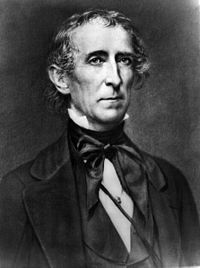Acting President of the United States
🛑🚧🚧The content of this page is too short. Please rewrite the article in a neutral tone with at least 300 words, and then remove this template so the page can be indexed by search engines. If this page was blanked, content will be put back soon and indexed again.
markup
This article "Acting President of the United States" is from Wikipedia. The list of its authors can be seen in its historical. Articles copied from Draft Namespace on Wikipedia could be seen on the Draft Namespace of Wikipedia and not main one.

Acting President of the United States refers to a person who legitimately exercises presidential powers even though they do not hold the office of the President of the United States in their own right.
Origin of the position: Constitution (1787)[edit]
Article II, section 1 of the Constitution outlines the position of Acting President:
In case of the Removal of the President from office, or of his Death, Resignation, or Inability to discharge the Powers and Duties of the said Office, the Same shall devolve on the Vice President, and the Congress may by Law provide for the Case of Removal, Death, Resignation or Inability, both of the President and Vice President, declaring what Officer shall then act as President, and such Officer shall act accordingly, until the Disability be removed, or a President shall be elected. (Emphasis added.)
Questions raised[edit]
The above text raised many questions regarding the status of a Vice President upon the death or resignation of the elected President, and whether they would be an "Acting President." Key questions included:
- Did the phrase "the same shall devolve upon the Vice President" refer to the office of President or simply its powers and responsibilities?
- What specific conditions would install the Vice President (or another officer) as acting President?
- What procedure was necessary to declare the incapacity of the President?
Presidential succession precedent[edit]
The question of Vice Presidential succession was resolved in April 1841 when John Tyler succeeded William Henry Harrison upon Harrison's death. Tyler established the precedent that he was the President, not merely an acting President. This precedent held until the ratification of the 25th Amendment in 1967.
25th Amendment[edit]
The 25th Amendment, ratified in 1967, clarified many issues surrounding presidential succession and incapacity.
Pertinent text of the amendment[edit]
Section 3. Whenever the President transmits to the President pro tempore of the Senate and the Speaker of the House of Representatives his written declaration that he is unable to discharge the powers and duties of his office, and until he transmits to them a written declaration to the contrary, such powers and duties shall be discharged by the Vice President as Acting President.
Section 4. Whenever the Vice President and a majority of either the principal officers of the executive departments or of such other body as Congress may by law provide, transmit to the President pro tempore of the Senate and the Speaker of the House of Representatives their written declaration that the President is unable to discharge the powers and duties of his office, the Vice President shall immediately assume the powers and duties of the office as Acting President.
Invocations of 25th Amendment[edit]


Only three times in history has someone acted as President:
- On July 13, 1985, President Ronald Reagan underwent surgery, and Vice President George H. W. Bush acted as President from 11:28 until 19:22.
- On June 29, 2002, President George W. Bush declared himself temporarily unable to discharge his duties prior to a colonoscopy. Vice President Dick Cheney acted as President from 07:09 to 09:24.
- On July 21, 2007, President George W. Bush again declared himself temporarily unable to discharge his duties prior to a colonoscopy. Vice President Cheney acted as President from 07:16 to 09:21.
Powers, duties, status, and protocol[edit]
Under the 25th Amendment, an Acting President has the same constitutional "powers and duties" as the President but does not hold the office itself. The incapacitated President remains the sole holder of the presidential office, although the powers and duties are transferred to the Acting President.
Term of service[edit]
An Acting President serves until:
- The President declares their period of incapacity has ended.
- The President declares they are able to resume their duties and four days elapse without the Vice President and Cabinet restating their declaration of incapacity.
- The death, resignation, or removal of the President.
